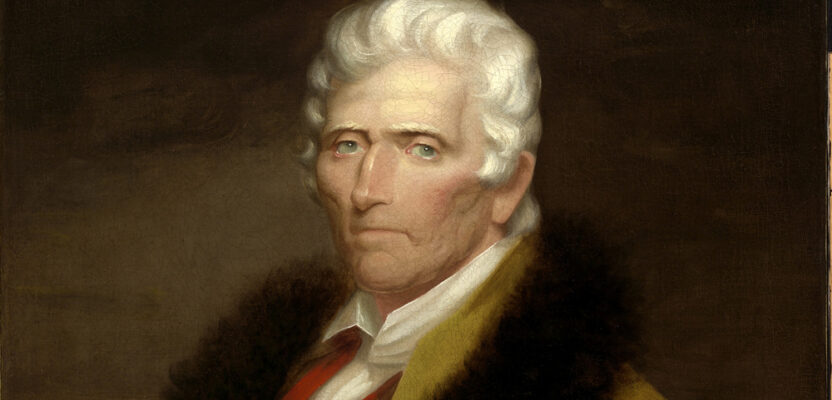Daniel Boone was a man. Yes a big man.
With an eye like an eagle and as tall as a mountain was he.
Daniel Boone was a man. Yes a big man.
He was brave, he was fearless and as tough as a mighty oak tree.
From the coonskin cap on the top of ol’ Dan to the heel of his rawhide shoe.
The rippin’est roarin’est fightin’est man the frontier ever knew.
Daniel Boone was a man. Yes a big man.
And he fought for America to make all Americans free.
I vaguely remember hearing this theme song to the late-1960s TV show Daniel Boone as my older brother watched from the other room. I wasn’t old enough to watch, but apparently I wasn’t so young that a catchy jingle wouldn’t stick in my head for years.
The television show reinforced Boone as an iconic American pioneer and frontiersman, whose daring exploits made him an enduring hero of early American folklore. In real life, Boone was, indeed, an explorer who took on great danger to open up the vast territory west of the Appalachian Mountains. History and the television show say he specifically began settlement of the territory that would become Kentucky and both recount his heroic rough-and-tumble adventures in the dangerous wilderness.
I relay this story because of all of Daniel’s heroics – real and legendary – I don’t believe the television show or very much of his folklore legend mentions that he was a surveyor. I guess the exploits of his surveying life didn’t compare to his life as a warrior and pioneer, so those details largely got consumed by history. Besides, not many words rhyme with surveyor so it would have been an awkward fact to fit into the theme song.
In 18th-century America, a surveyor’s work was indispensable in settling the American frontier. It was a difficult and dangerous job, first in simply getting to the new territory and then in dealing with all of the hardships pioneers and explorers faced in those days.
Boone led a team of about 30 woodsmen blazing the Wilderness Road through the Cumberland Gap into what would become Kentucky. The Wilderness Road would become the route thousands of settlers would follow to the western frontier.
Once in the territory, Boone founded Boonesborough, one of the first English speaking settlements outside the colonies. A replica of Fort Boonesborough, which Boone built and used as his home base, is a state park along the Kentucky River just southeast of Lexington.
Col. Richard Henderson and the founders of the land-speculating Transylvania Company hired Boone to negotiate the purchase of territory between the Kentucky and Cumberland rivers with the native Cherokee tribe. Once the transaction was complete, Boone did much of the surveying necessary to privatize the land for the settlers who would eventually push west.
“In the fall of 1782 … Daniel Boone began to interest himself in land surveying in the wilderness,” Kentucky historian Willard Rouse Jillson wrote in 1946. “Since he had had the benefit of practically no formal schooling or academic training of any kind, it was, no doubt, his ability as a woodsman and his broad acquaintance with the forest covered terrain of the Bluegrass country that served to bring about the demand for his services as a land surveyor.
“Thoroughly familiar for many years with the use of a compass, the rudiments of its technical application to land measurement with a chain were probably not really difficult for Boone. No doubt his natural aptitude, good judgment, high courage, ever present sense of direction and reputation for unswerving honesty were personal characteristics that gave him high rating among his fellow professional surveyors and the pioneering settlers generally.”
Sometime in the early 1780s Boone became deputy surveyor of Fayette County, Virginia, territory that eventually became Clark County, Kentucky. Surviving records show he completed 163 surveys in the new territory, covering approximately 625 square miles, an area roughly half the size of Rhode Island.
Many of his early surveys were for Capt. William “Billy” Bush, who led a group of Baptist families to settle on Lower Howard’s Creek. Bush laid claim to thousands of acres of land, and Boone’s surveys became the foundation of the Bush Settlement.
Much of the records of his work have been lost to time, but many remain in the Kentucky Land Office in Frankfort, overlooked, as Jillson wrote:
“Authors, addressed more to literature than to history, will probably continue to write and rewrite the old, yet ever-fascinating story of the heroic life of Kentucky’s great scout and hunter, but scholars, at the same time, turning the fading pages of these original 18th century documents will find no doubt … new and deep welling springs of information on the life, the associates and the land surveying activities of Daniel Boone.”
If the surveying aspect of Boone’s life didn’t make for good television or folklore, it certainly made real life easier for those who followed him west. A big man, indeed.

